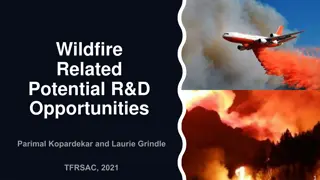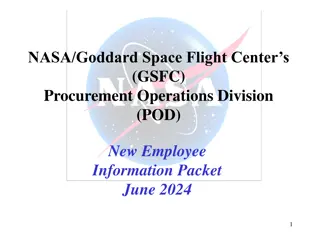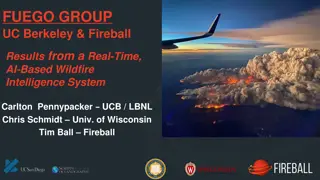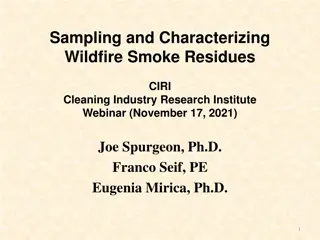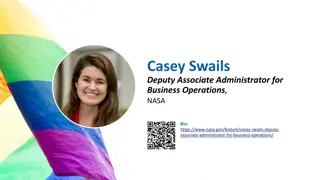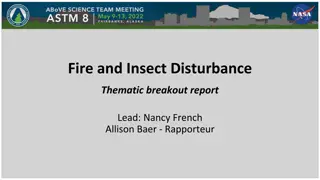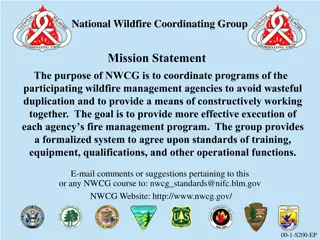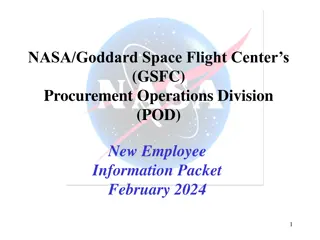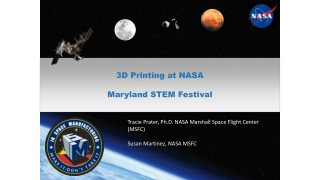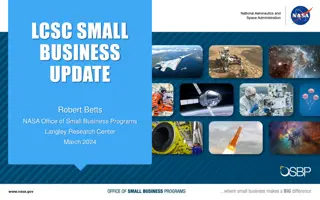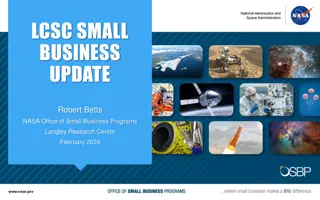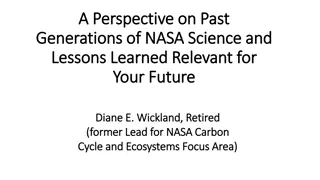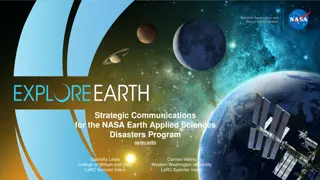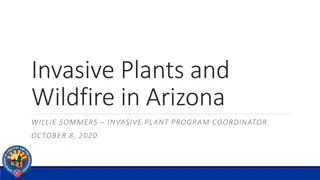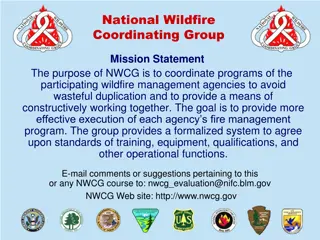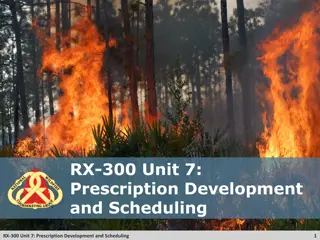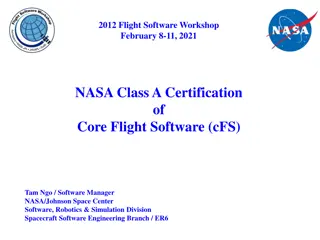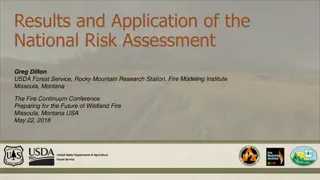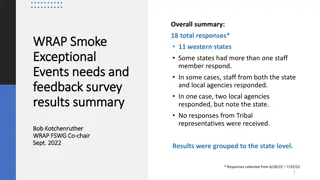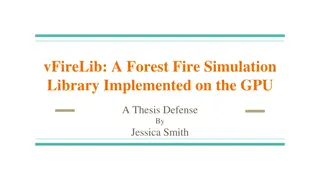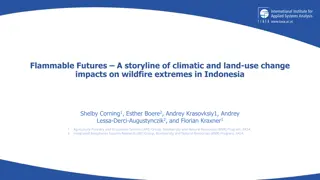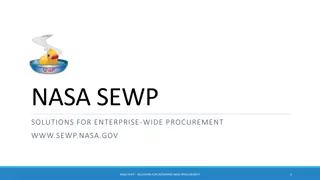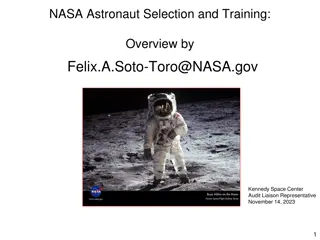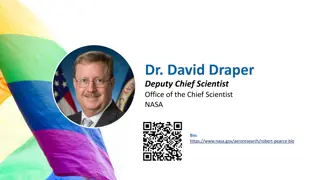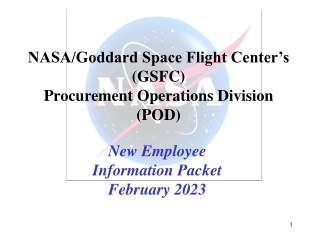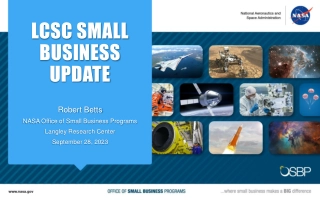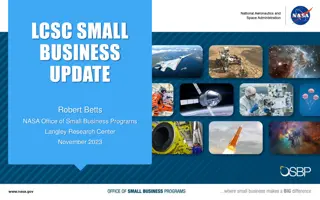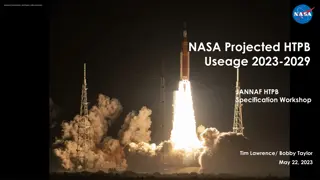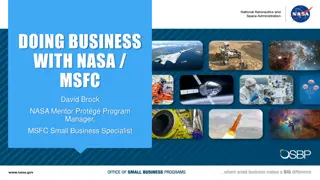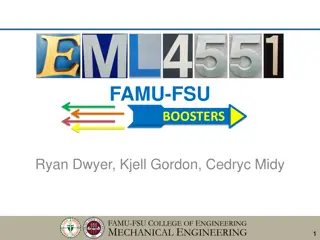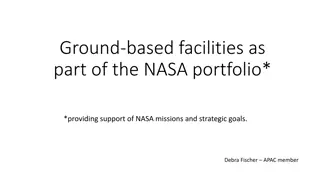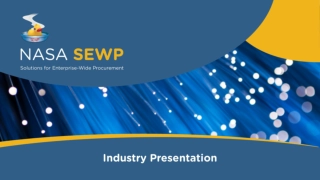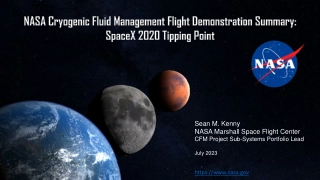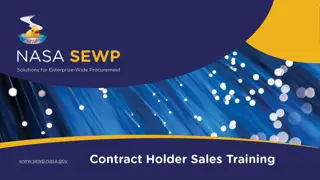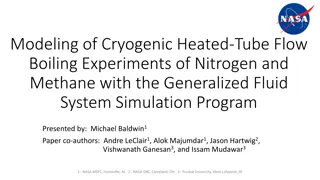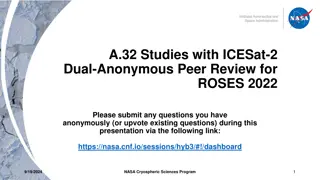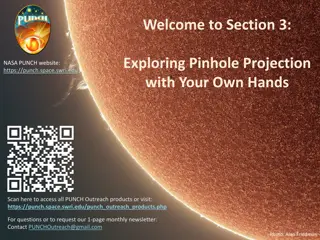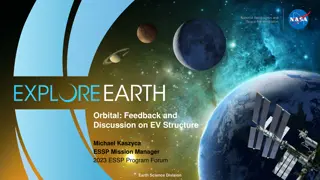NASA Wildfire Management Program Overview
NASA's Applied Science Program focuses on wildfire management efforts through the ROSES-2011.A.35 solicitation, aiming to enhance decision-making and actions related to wildland fires. The program supports research projects, collaborations with the fire community and sister agencies, and outreach activities to expand knowledge and involvement in wildfire management. With a total funding of $6 million over FY12-16, NASA emphasizes feasibility-to-decision support projects to identify high-reward initiatives with partner organizations' commitment for successful outcomes.
Download Presentation

Please find below an Image/Link to download the presentation.
The content on the website is provided AS IS for your information and personal use only. It may not be sold, licensed, or shared on other websites without obtaining consent from the author. Download presentation by click this link. If you encounter any issues during the download, it is possible that the publisher has removed the file from their server.
E N D
Presentation Transcript
NASA Outlook and Focus Vince Ambrosia NASA Applied Science Program: Assoc. Program Manager - Wildfires Science Mission Directorate Earth Science Division
New Fire Support Efforts at NASA ROSES 2011 A.35 Wildfires solicitation (Applied Science Program); portfolio management / program management; Down-select to nine (9) Phase II Wildfire Projects; Interface with Fire Community / Sister Agencies; develop collaborations, possible joint solicitations; Manage project efforts and metrics; Support / Represent the agency on various national /international committees to expand knowledge on NASA involvement in wildfire management efforts. Develop outreach of program efforts through workshops, conferences, etc.
ROSES-2011 A.35 Down-Select Solicitation (Section 2) The objective of this solicitation is to select applications and applied research projects to improve decision-making activities and actions on topics related to wildland fires, such as wildfires, rangeland fires, and prescribed fires. Successful projects will advance organizations use and application of Earth observations in analysis and assessments, management strategies and actions, business practices, and policy analysis and decisions associated with wildland fires. | 3
ROSES-2011 A.35 Total Amount of NASA Funding (FY12-16) $6 M total (Stage 1: ~1.5M; Stage 2: ~4.5M) 9-13 projects $120K - $170K 1 year 6 months after proposal due date. Strongly encouraged. However, partner funding does not count toward funding level guidelines. 4-6 projects $275K - $450K (per annum funding scenarios depend on partnerships/cost sharing levels) 3 years 18-20 months after proposal due date Transition plan with resource commitments from partner organizations is expected Anticipated Number of Stage 1 Awards Expected Range of Stage 1 Award per project Period of Performance (Stage 1) Expected Project Start Date (Stage 1) Contributions from Partner Organizations (Stage 1) Anticipated Number of Stage 2 Awards Expected Range of Stage 2 Awards per project (NASA funding) Period of Performance (Stage 2) Expected Project Start Date (Stage 2) Contributions from Partner Organizations (Stage 2) | 4
SMD/ESD Applied Sciences Program Feasibility-to-Decision Support Projects A two-stage approach to identify more high-reward projects with strong commitment by partner organizations. Start with multiple feasibility studies of possible applications ideas. After a year, the Program selects a subset of successful studies to pursue as in-depth applications projects. Approach generates numerous applications ideas and focuses investments on those with high-reward potential. Approach prioritizes partners skin-in-the-game to increase their involvement in project and commitment to adopting the project results. NASA Share Partner Share Year Stage Activity Prove out application potential Year 1 Feasibility 100% Optional Decision Support Year 2 Develop application ~80% ~20% Decision Support Year 3 Continue development ~60-70% ~30-40% Decision Support Complete application and transition Year 4 ~30-40% ~60-70% | 5
Applied Sciences 2008 Solicitation Selections of Phase II Projects Zachary Holden / USDA Forest Service: A Prototype System for Predicting Insect and Climate-Induced Impacts on Fire Hazard in Complex Terrain; Stephen Howard / USGS EROS Center: Utilization of Multi-Sensor Active Fire Detections to Map Fires in the US; Mary Ellen Miller / Michigan Tech Research Institute (MTRI): Linking Remote Sensing and Process-Based Hydrological Models to Increase Understanding of Wildfire Effects on Watersheds and Improve Post-Fire Remediation Efforts; Birgit Peterson / USGS EROS Center: Enhanced Wildland Fire Management Decision Support Using Lidar-Infused LANDFIRE Data; Sher Schranz / NOAA: Wildland Fire Behavior and Risk Prediction; Wilfrid Schroeder / University of Maryland Development and Application of Spatially Refined Remote Sensing Active Fire Data Sets in Support of Fire Monitoring, Management and Planning; Karyn Tabor / Conservation International Foundation An Integrated Forest and Fire Monitoring and Forecasting System for Improved Forest Management in the Tropics; James Vogelmann / National Center for Earth Resources Observation and Science (USGS EROS Center); Improving National Shrub and Grass Fuel Maps Using Remotely Sensed Data and Biogeochemical Modeling to Support Fire Risk Assessments; Keith Weber / Idaho State University RECOVER: Rehabilitation Capability Convergence for Ecosystem Recovery; | 6
Current & Upcoming Activities Develop Phase II Project team 1st Year Review and Planning Workshop (January 15 at RSAC / SLC; 16 at NIFC / Boise; 17 at TBD Futurecasting Summit: The Future of Wildfires, AFA, Colorado Springs,13-14 February. Develop trend analysis of technology and wildfire crossroads in 2024. Discussions with NRC (Drs Elizabeth Eide and Mark Lange, Director and Program Officer (respectively), Board on Earth Sciences and Resources) about potential NRC study to examine how science can help wildfire planning and management be more strategic, reduce costs, and increase the land s resilience to wildfire ;
Active & Upcoming Activities Participated in JFSP National Fire Science Exchange Meeting, Tucson, AZ, 6-8 May. Develop ideas for joint solicitation of projects / campaigns; build closer relationships Participate in Large Wildland Fire Conference, Missoula, MT, 20-23 May. Expose community to NASA s growing portfolio in wildfire remote sensing applications Committee membership (rep NASA) on GEO 2012-2015 Work Plan, element DI-01--Disasters; Risk Reduction , Group C4: Global Wildfire Information System; NASA repped at Wildland Fire Science & Technology Task Force (Amber Soja); Sponsored and supported NASA exhibit at IUFRO, Salt Lake City, UT. 5-12 October 2014.
Active & Upcoming Activities Participate and address NASA s ASP-Wildfire program element at International Conference on Forest Fire Research, Coimbra, Portugal, November 2014. Possible NASA Conference support / display; ISRSE 2015 Berlin, Program Technical Committee; Theme Chair of Disasters Theme and Airborne Theme. Organized special sessions on Wildfires (Disaster Theme) and UAS for Resource Assessment (Airborne Theme). Still open for abstract submissions. Organized Special Session on NASA Wildfire Applications at Pecora Conference, Denver, CO, November, Amber Soja Chair. NASA rep on IARPC Wildfire Implementation Team; developed a document on orbital and airborne wildfire remote sensing assets that is web-served by the IARPC.
Wildfires as Input to NASA Decadal Survey Major 1.5 year activity: Development of wildfire applications component of the NASA forthcoming Decadal Survey with wildfire community (workshops, requirements assessment for improved measurement of wildfire: Recommendation for new observations systems Improved Models Contributions of wildfire to climate change The report will be provided to NRC for implementation into NASA Decadal Survey, with recommendations of agency focul and agenda for next ten years (from implementation).
NASA Questions? AMS Washington Forum Federal Panel Vince Ambrosia Assoc. Program Manager Wildfires vincent.g.ambrosia@nasa.gov 1.650.604.6565 Michael H. Freilich 4 April 2013 Suomi NPP VIIRS Visible Composite



